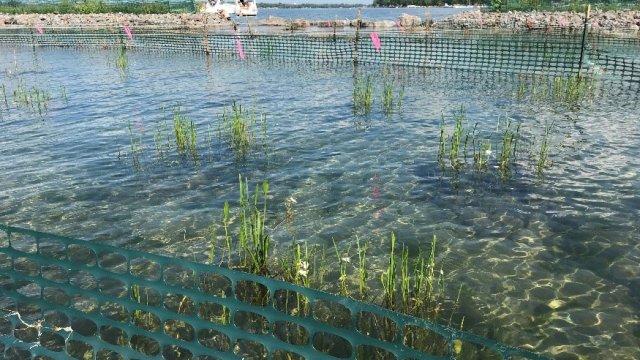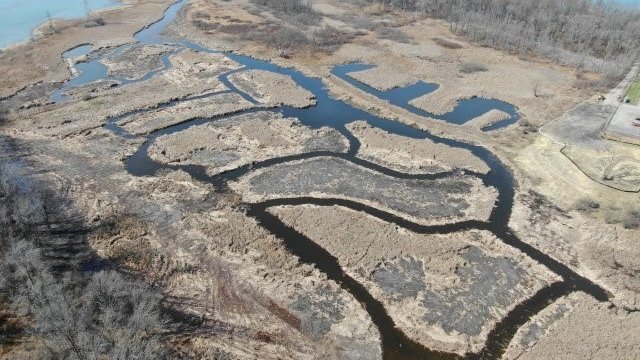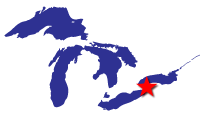Niagara River AOC
Courtney Winter
([email protected])
312-353-5657
Christopher Seslar
([email protected])
212-637-3810
On this page:
- Latest News
- Overview
- Beneficial Use Impairments
- Remediation and Restoration Work
- Project Highlights
- Partners
Latest News
- Video on Binational Habitat Restoration Efforts in the Niagara River AOC
- Construction Begins for the Niagara River AOC Habitat Project, Outer Harbor Slip
- USACE Buffalo District Constructs Emerald Shiner Passage Structure
Overview
The Niagara River is located in both Erie and Niagara counties in western New York. In 1987 the Niagara River was designated an Area of Concern (AOC) as part of the Great Lakes Water Quality Agreement of 1987.
The Niagara River is a binational AOC that includes the entire Niagara River. The U.S. side of the AOC consists of an Impact AOC and a Source AOC. The Impact AOC extends from the mouth of Smoke Creek near the southern end of the Buffalo Outer Harbor (which is within Lake Erie) north to the mouth of the Niagara River at Lake Ontario. Within the river, the international border between Canada and the U.S. forms part of the Impact AOC boundary. On the landward side, the Impact AOC boundary follows the shoreline. In the Outer Harbor area, the in-water boundary generally follows the major breakwalls. In the southernmost section, where no breakwall is present, the AOC extends approximately one-half mile from shore. The Source AOC consists of portions of five tributaries to the AOC, as described below. In each case, the Source AOC includes the full width of the stream channel, but no upland areas beyond the top of the shoreline embankment.
- Smoke Creek (main stem) from its mouth to South Shore Blvd.
- South Branch Smoke Creek from its confluence with the main stem of the Creek to South Park Avenue
- Scajaquada Creek from its mouth to the Scajaquada Drain outfall, including Hoyt Lake
- Cayuga Creek from its mouth to Walmore Road
- Gill Creek from its mouth to Porter Road
At the beginning of the 20th century, the cities of Buffalo, Tonawanda and Niagara Falls received significant expansions in steel and chemical manufacturing, as well as grain milling along the shoreline of the Niagara River. This was due to open land and the availability of electricity and cooling water from Niagara Falls. Steel, petrochemical, and chemical manufacturing industries flourished along the Niagara River into the late 1970s. Subsequently, they declined, leaving behind a legacy of contamination.
Post-industrial and municipal discharges degraded water quality, habitat, and contaminated sediment. The survival of aquatic life in the AOC has been impacted and impaired by toxic chemicals such as PCBs, dioxin, dibenzofuran, PAHs and pesticides.
Six federal National Priority List (NPL) sites, other hazardous waste sites, urban development, and contaminated discharges from Lake Erie’s watershed, have all been sources of pollution to the area and have led to its designation as an AOC. In addition to Great Lakes Restoration Initiative efforts, federal and state governments and responsible parties have collectively spent hundreds of millions to remediate hazardous waste sites.
Beneficial Use Impairments
- Restrictions on Fish and Wildlife Consumption
- Fish Tumors or Other Deformities - Removed January 2016
- Degradation of Benthos
- Restrictions on Dredging Activities
- Loss of Fish and Wildlife Habitat
- Degradation of Fish and Wildlife Populations
- Bird or Animal Deformities or Reproduction Problems
General information about BUIs: Beneficial Use Impairments for the Great Lakes AOCs
Remediation and Restoration Work
Significant progress has been made towards remediating and restoring the Niagara River AOC. The Niagara River AOC Habitat Restoration Plan was finalized in 2019. The plan outlines the management actions necessary to remove the Loss of Fish and Wildlife Habitat BUI. Within this plan, 12 habitat restoration projects have been identified. Of those, six are either under way or completed. Together, the projects will restore approximately 100 acres of shallow water/coastal wetland habitat.
Project Highlights
-
Buckhorn Island/Grass Island

Installing rock reefs protects vegetation from waves and ice scour.
-
Emerald Shiner Fish Passage

Repairing seawall to support emerald shiner migration.
-
Spicer Creek Wildlife Management Area

Restoring wetland habitat through the promotion of shallow-water vegetation growth.
-
East River Marsh Extension

Protecting and enhancing shallow water coastal wetlands.
-
Burnt Ship Creek

Improving water movement through the marsh.
-
Black Rock Canal Cleanup

Removing 180,000 cubic yards of contaminated sediments from the navigation channel.
Partners
The Niagara River AOC partners are outlining necessary actions needed for contaminated sediment remediation work throughout the AOC. Sediment contamination is a large impediment for the Niagara River AOC, with several BUI designations linked to it as the cause of impairment. Over the next several years, federal and state agencies and partners will continue to work together to make progress that will eventually lead to BUI removals and the delisting of the Niagara River AOC.
- National Oceanic and Atmospheric Administration
- U.S. Army Corps of Engineers – Buffalo District
- U.S. Fish and Wildlife Service
- U.S. Geological Survey
- Buffalo Niagara Waterkeeper
- Canadian Niagara River RAP
- Great Lakes Research Consortium
- New York State Department of Environmental Conservation
- New York State Office of Parks, Recreation and Historic Preservation
- New York Sea Grant
- Niagara River Greenway Commission


